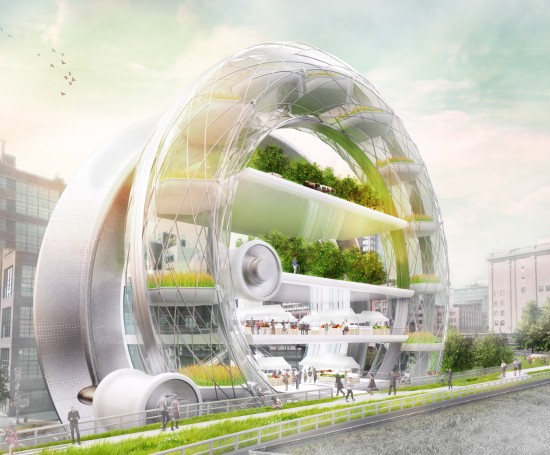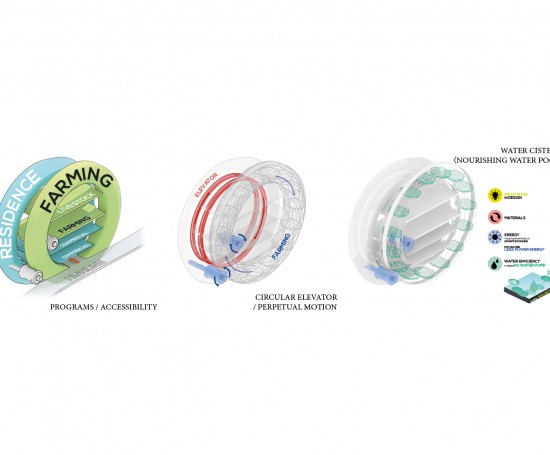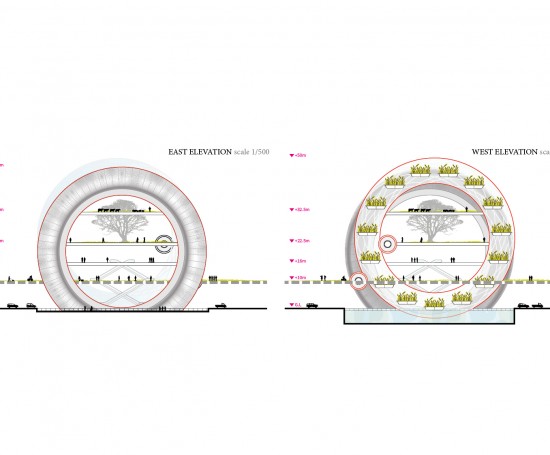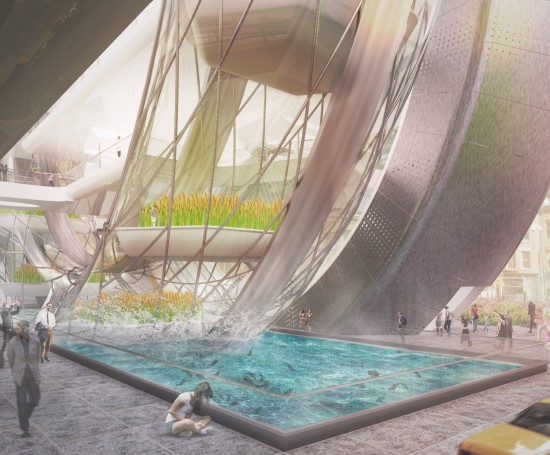High_Circle
High Circle
TYPE: International Competition
STATUS: Proposed
SITE AREA: 1,432 m2
TOTAL FLOOR AREA: 5055 m2
BUILDING AREA: 1077 m2
BUILDING COVERAGE RATIO: 75 %
FLOOR AREA RATIO: 353%
FARM AREA: 1,980 m2 (645 m2 on Spinning Wheel/1,335 m2 on Deck)
RESIDENTIAL AREA: 2,010 m2 (38 Households)
COMMERCIAL AREA: 645 m2
SERVICE AREA: 420 m2
Partner in Charge: June Ho Kim
Project Leader: Huida Jeong
Team: Jin-Hui Yeo, Gyu Hyun Choi
Introduction
Highly dense cities are relatively exposed to the low opportunities to gain natural resources: vegetables, fruits, fish, chickens, beef, and etc., from a distance.
Even, annually tons of foods are transported over thousands of miles to cities. These high costs of food mileages and reliance on imported food are basically derived from the limited arable land in urban area.
Along the same line, utilizing a concept of vertical farmland in a dense vertical community is an alternative of the self-efficient way that directly contrasts the typical means of today’s consumption.
For instance, a mix-used vertical farm tower will become a model of culture that is a suitable apparatus, enriched with an exchange of local production and a platform for the community to gather, and a more sustainable food distribution system, reducing energy and transportation cost in New York City.
Site Approach
As a challenge to counter those issues, our proposal, ‘HIGH CIRCLE’, planned to border New York City’s High Line, a unique urban conversion into a popular linear park which is an effort to save a practically inactive portion of elevated rail line in lower Manhattan.
The high line is a public phenomenon that lies not in the realm of the street but in the center of the city’s block structure with vegetation that spontaneously overgrew it. Our struggle between farming and living continues this line of adjacent urban context as a first step forward.
As an extension of the social, environmental and economic consideration, it is important not to think about how residents can achieve natural resources better from a distance, but to actively engage with nature and create new groups of people who foster a new level of social interface and engage a community from farm to market, beyond the just stacked farmland with modern farming technology to maximize crop yields.
Design Approach
In the projected suggestion, the three major components which are mid-rise residential tower with arable fields, spinning structure for hydroponic units via perpetual motion, and nourishing water pool (water cistern) through rain-recycling. Each sectional adaption of the mix-used vertical farm tower has its own special characteristic which is in usable forms and suitable for various farming conditions.
-Residential Tower/Circulation
The residential tower contains 38 residential units, 2,010 m2 with a single farmland, farm area, 1,980 m2 (645 m2 on spinning wheel/1,335 m2 on deck), cultivating fruits, vegetables, and livestock that serve at the building, and commercial area as a market place.
While the upper portions provide open to air farming decks for medium based vegetation, fruits, and livestock, the middle portions provide more controlled environments for massive productions. The lower portions propose to host a variety of operating the social, environmental and economic activities to engage the public and to enhance trade, improve the environment and the entire neighboring farm.
Independent Multi-car Circular Elevator (IMCE) along a circulating path allows the urban habitats to encourage a unique accessibility from residential, commercial area to farming deck space. Furthermore, the IMCE distributes the kinetic energy back from descending cars to the ascending cars and so to create an equal energy cycle with the classic counterweights.
-Spinning Structure/Valid Actuating Force/Energy Efficiency
To achieve energy-saving, the original idea of the adopted spinning structure, enclosed by the metal fabric in suggestion, is originated from perpetual that continues indefinitely without any external source of energy.
Despite of the clear awareness of impossibility of infinite motion within the current physical laws, the way of spinning structure using both hydroponic and soil based farming through basket units, showcases the long term benefits and sustainability, technology of urban agriculture to practice alternative food distribution and production by creating more urban farmland and reducing food mileage in NYC.
Beyond a deep interest and aesthetic improvement, it exposes urban neighbors and visitors to growing corps and interaction with farmland and provides improvement in habitation productivity in the living place.
-Water Cistern (Nourishing Water Pool)
Not like other delusive vertical farm towers with conventional water pipe and vertical shafts, the nourishing water pool interacted with the spinning wheel, plugged on street level in order to provide on-site irrigation for indoor and outdoor plants and farming deck space and to facilitate the need for water-supply and the management of the crop’s pots.
Project Evaluation
While food production in urban habitats is reaching maximum capacity, with population growth, our considerations focus not on the imposed standards of energy offsets and strict efficiency rates, but rather on an idea of a farming building that can change the way people think about their daily lives with local productions which comes local exchange.
The challenge, ‘HIGH CIRCLE’, a new model of vertical farming can be tested and resolved in a dense vertical community. As current trends in development create a struggle between farming and living, the project has comprehensively applied architectural and mechanical energy-saving methods, and programs focusing on farming methods and practices.
As a direct injection of goods from farm to market, enriched with an exchange of local produce, and a place for the community to gather, the mix-used vertical farm tower believes in the long term benefits and sustainability in recruiting new urban farmers to practice alternative food distribution and production by creating more urban farmland and reducing food mileage in NYC.




